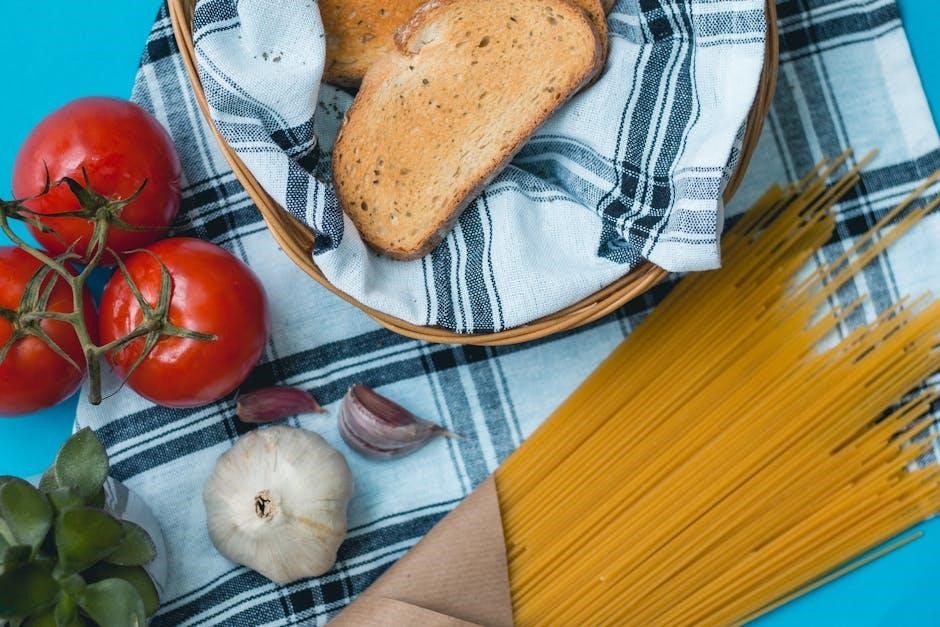Ready to make some New York-style garlic bread? These instructions will guide you to golden, buttery perfection․ Whether you’re using a classic baguette or opting for sourdough, follow these steps for the perfect side to any meal! Let’s get cooking with garlic!
New York-style garlic bread is more than just a side dish; it’s an experience․ Imagine sinking your teeth into a slice of perfectly crisp bread, infused with the rich aroma of garlic and butter, a staple in many New York pizzerias and Italian restaurants․ Unlike its bland, mass-produced counterparts, authentic New York garlic bread boasts a robust flavor profile achieved through simple yet crucial techniques․
This isn’t just about slapping some garlic butter on bread․ It’s about understanding the balance of flavors, the importance of fresh ingredients, and the art of achieving the perfect texture․ From selecting the right type of bread to preparing the garlic butter with fresh herbs, every step contributes to the creation of a culinary masterpiece․
Whether you’re pairing it with a hearty bowl of pasta, using it to soak up the last bits of sauce, or enjoying it on its own, New York-style garlic bread elevates any meal․ It’s a nostalgic comfort food that brings back memories of cozy dinners and bustling city streets․ So, get ready to embark on a journey to create garlic bread that will rival your favorite New York spot․
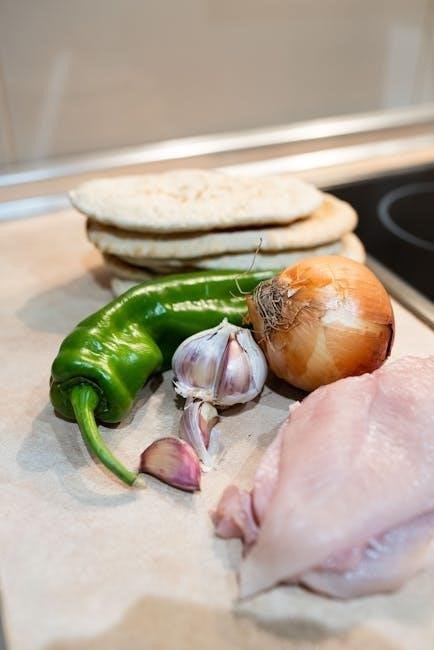
Essential Ingredients for Authentic Flavor
Crafting authentic New York-style garlic bread hinges on a few key ingredients, each playing a crucial role in achieving that unmistakable flavor․ First and foremost, high-quality butter is essential․ Opt for unsalted butter to control the overall saltiness, allowing the other flavors to shine․ Fresh garlic is non-negotiable; pre-minced garlic simply won’t deliver the same pungent, aromatic punch․
Next, consider fresh herbs․ Parsley is a classic choice, adding a touch of brightness and freshness that complements the richness of the butter and garlic․ Parmesan cheese, freshly grated, provides a salty, umami depth that elevates the flavor profile․ A pinch of red pepper flakes can add a subtle kick, balancing the richness with a touch of heat․
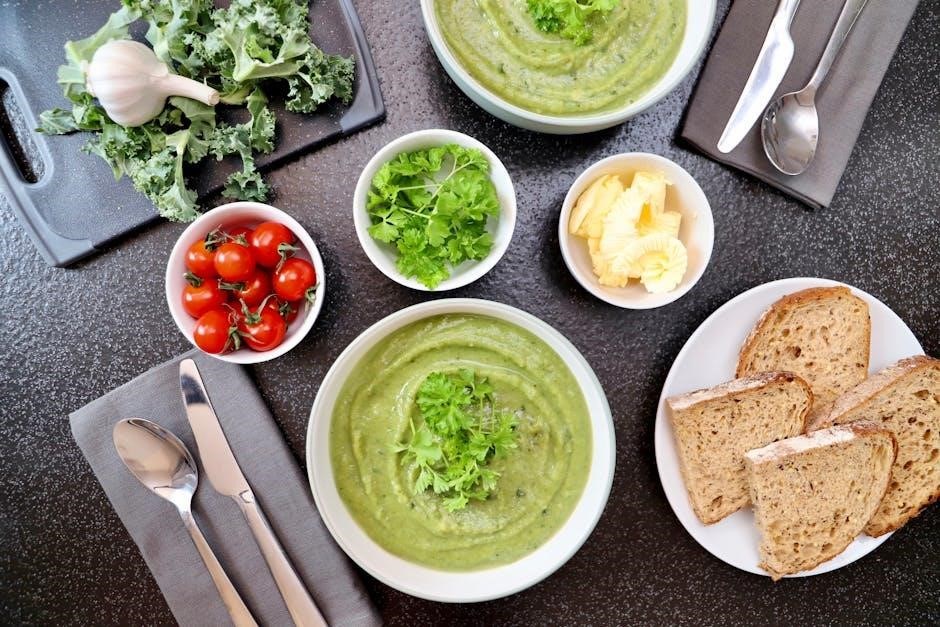
Finally, don’t forget the bread itself․ A good quality baguette or sourdough loaf is crucial for providing the perfect canvas for the garlic butter․ The bread should be sturdy enough to hold its shape but with a soft interior․ With these essential ingredients in hand, you’re well on your way to creating garlic bread that captures the essence of New York․
Choosing the Right Bread: Baguette vs․ Sourdough
Selecting the perfect bread is crucial for achieving the desired texture and flavor in your New York-style garlic bread․ The two most popular choices are baguettes and sourdough, each offering a unique experience․ Baguettes, with their long, slender shape and crisp crust, provide a classic garlic bread texture․ Their relatively neutral flavor allows the garlic butter to truly shine, making them an excellent choice for purists․
Sourdough, on the other hand, brings a tangy, complex flavor that adds a distinctive twist to the garlic bread․ Its denser crumb provides a satisfying chew, and its robust structure can stand up to generous amounts of garlic butter․ The crust of sourdough tends to be chewier and more substantial than that of a baguette, offering a delightful textural contrast․
Ultimately, the choice between baguette and sourdough depends on your personal preference․ If you prefer a classic, straightforward garlic bread, a baguette is the way to go․ If you’re looking for a more complex flavor profile and a heartier texture, sourdough is an excellent choice․ Consider the strength of the garlic butter you intend to use; a bolder garlic butter may pair better with the tangy sourdough․
Preparing the Garlic Butter: Fresh vs․ Roasted Garlic
The heart of any great garlic bread lies in its garlic butter, and the choice between fresh and roasted garlic significantly impacts the final flavor․ Fresh garlic delivers a pungent, sharp bite that is characteristic of classic garlic bread․ When using fresh garlic, mince it finely to ensure even distribution and prevent overpowering bites․ Some prefer grating the garlic for an even finer texture that melds seamlessly into the butter․
Roasted garlic, on the other hand, offers a mellow, sweet, and almost caramelized flavor․ Roasting garlic transforms its harshness into a smooth, buttery essence that complements the bread beautifully․ To roast garlic, simply slice off the top of a whole head, drizzle with olive oil, wrap in foil, and bake until soft and fragrant․ Once cooled, the cloves can be easily squeezed out and mashed into the butter․
For a balanced flavor, consider combining both fresh and roasted garlic․ The fresh garlic provides the initial zing, while the roasted garlic adds depth and sweetness․ Experiment with different ratios to find your perfect blend․ Remember to use high-quality unsalted butter as your base, allowing the garlic to truly shine․ Whether you choose fresh, roasted, or a combination, ensure the garlic is evenly incorporated into the softened butter for a consistently flavorful spread․
Adding Herbs: Parsley, Basil, and Oregano Options
Fresh herbs elevate garlic bread from simple to sublime, infusing aromatic notes that complement the garlic and butter․ Parsley, basil, and oregano are excellent choices, each offering a unique flavor profile․ Parsley provides a fresh, clean taste that brightens the overall flavor․ Its mildness makes it a versatile option that pairs well with both fresh and roasted garlic․ Finely chopped flat-leaf parsley is ideal for even distribution․
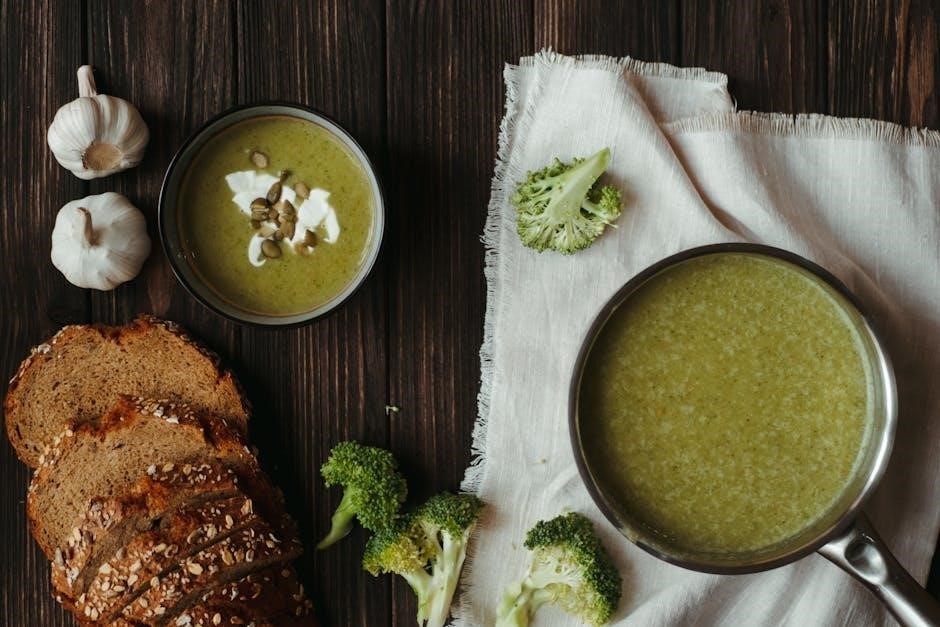
Basil introduces a sweet, slightly peppery note, reminiscent of Italian cuisine․ Its fragrant leaves add a layer of complexity, especially when combined with Parmesan cheese․ Fresh basil should be added just before baking to preserve its delicate flavor․
Oregano brings a robust, earthy flavor that stands up well to the intensity of garlic․ Its slightly pungent aroma adds warmth and depth․ Dried oregano can be used if fresh is unavailable, but remember to use it sparingly as its flavor is more concentrated․ Experiment with combinations of these herbs to create your signature garlic bread․ Consider adding a pinch of red pepper flakes for a subtle kick․ Always use fresh, high-quality herbs for the best results, and chop them finely to ensure they blend seamlessly into the garlic butter․
Cheese Variations: Parmesan, Mozzarella, and More
Adding cheese to garlic bread transforms it into a decadent treat, offering a variety of flavors and textures․ Parmesan, mozzarella, and other cheeses can be used to customize your garlic bread to your liking․ Parmesan provides a salty, nutty flavor that complements the garlic and herbs․ Grated Parmesan melts beautifully, creating a crispy, golden crust․
Mozzarella offers a mild, creamy flavor and a stretchy, gooey texture when melted․ It’s perfect for creating pull-apart garlic bread․ Tuck pieces of mozzarella into slits in the bread before baking for an extra cheesy experience․
Other cheese options include provolone, which offers a slightly sharper flavor and a smooth, melted texture․ Asiago provides a nutty, slightly tangy flavor that pairs well with roasted garlic․ For a bolder flavor, consider using a blend of cheeses, such as Parmesan and provolone, or mozzarella and Asiago․ Experiment with different combinations to find your favorite․
Remember to use high-quality cheeses for the best results, and grate or shred them finely for even melting․ A sprinkle of cheese on top of the garlic butter adds a delicious finishing touch․
Step-by-Step Cooking Instructions: Oven Method
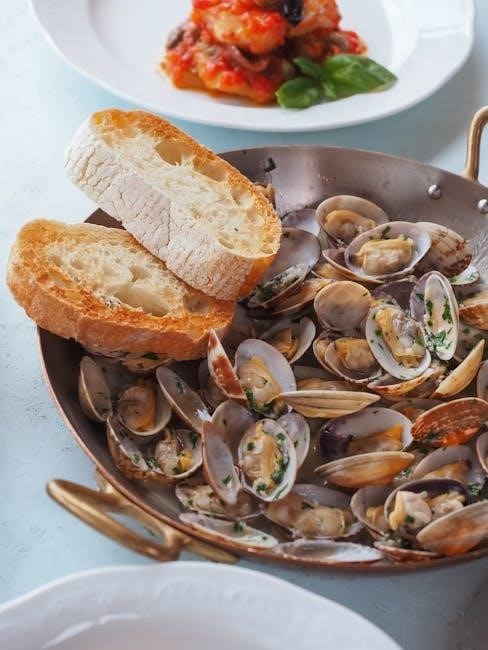
Creating garlic bread in the oven is simple․ Begin by preheating your oven to 400°F (200°C)․ While the oven heats, prepare your garlic butter․ Slice your bread loaf lengthwise․ Brush the cut sides generously with the prepared garlic butter․ Ensure the garlic is evenly distributed․ If you’re adding cheese, sprinkle it over the garlic butter․
Place the bread cut-side up on a baking sheet lined with parchment paper or foil․ Bake for 10-15 minutes, or until the bread is golden brown and the cheese is melted and bubbly․ Keep a close eye on it to prevent burning․
For a crispier crust, broil for the last minute or two, watching carefully․ Remove the garlic bread from the oven and let it cool slightly before slicing․ Serve warm and enjoy the flavors․ This oven method ensures a crispy crust and a soft, flavorful interior․
Adjust cooking time based on your oven and desired crispness․ Enjoy your homemade garlic bread!
Alternative Cooking Methods: Grill or Stovetop
Craving garlic bread but don’t want to turn on the oven? The grill and stovetop offer excellent alternatives․ For grilling, preheat your grill to medium heat․ Wrap the garlic buttered bread in foil and grill for about 10-15 minutes, flipping occasionally, until heated through․ Remove from the foil for the last few minutes to crisp the crust, watching carefully to prevent burning․
For the stovetop, melt butter in a skillet over medium heat․ Place the garlic buttered bread, cut-side down, in the skillet․ Cook for 3-5 minutes per side, until golden brown and crispy․ Monitor closely to avoid burning the garlic․
Both methods provide unique textures and flavors․ Grilling imparts a smoky taste, while the stovetop creates a wonderfully crisp crust․ Adjust cooking times to your preference and enjoy delicious garlic bread, regardless of your cooking method․ Experiment with both to find your favorite alternative․ Enjoy the versatility!
Tips for Achieving a Crispy Crust and Soft Interior
The key to perfect garlic bread is a crispy crust and a soft, chewy interior․ Start with high-quality bread, like a baguette or sourdough, for the best texture․ When applying the garlic butter, ensure even coverage without oversaturating the bread, which can lead to a soggy result․
For oven baking, preheating is crucial․ A hot oven helps to quickly crisp the exterior while keeping the inside soft․ Consider a two-step baking process: start with the bread wrapped in foil to steam the interior, then remove the foil during the last few minutes to achieve that golden-brown, crispy crust․
If using the grill or stovetop, keep a close eye to prevent burning․ Moderate heat and frequent turning will help ensure even cooking․ Ultimately, experimentation is key to finding your perfect balance of crispness and softness․ Enjoy the process and savor the delicious results!
Serving Suggestions: Pairings with Pasta and Soups
New York garlic bread is incredibly versatile and pairs wonderfully with many dishes․ Its classic pairing is, of course, with pasta․ Imagine warm, garlicky bread alongside a steaming bowl of spaghetti and meatballs or a creamy fettuccine Alfredo․ The bread is perfect for soaking up every last bit of delicious sauce․
Beyond pasta, consider serving your garlic bread with soups․ A hearty tomato soup or a rich minestrone becomes even more satisfying with a side of crispy garlic bread for dipping․ The garlic flavors complement the savory broth beautifully․ For a lighter option, pair it with a simple salad and a cup of creamy potato soup․
Don’t limit yourself to Italian dishes! Garlic bread can also enhance a comforting bowl of chili or even a spicy gumbo․ The possibilities are endless, making it a go-to side for a variety of meals․
Storage and Reheating Techniques
If you find yourself with leftover New York garlic bread, proper storage is key to maintaining its quality․ To keep it fresh, wrap the bread tightly in aluminum foil or store it in an airtight container at room temperature․ This will help prevent it from drying out and becoming stale․ For longer storage, you can freeze the garlic bread, again wrapped tightly, for up to a month․
When you’re ready to enjoy it again, reheating is simple․ For best results, preheat your oven to 350°F (175°C)․ Wrap the garlic bread in foil and bake for about 10-15 minutes, or until it’s heated through and the crust is crispy․ Alternatively, you can reheat individual slices in a toaster oven or under the broiler, keeping a close eye to prevent burning․ If frozen, thaw it before reheating for the best texture․ Avoid microwaving, as it can make the bread soggy․
Customization Options: Pesto and Other Additions
Elevate your New York garlic bread by exploring various customization options․ For a vibrant twist, spread a layer of basil pesto over the bread before adding the garlic butter and cheese․ The earthy, nutty flavors of pesto blend seamlessly, creating a unique and delicious flavor profile․
Consider adding a sprinkle of red pepper flakes to the garlic butter for a touch of heat․ Finely chopped sun-dried tomatoes can introduce a sweet and tangy element․ For a richer flavor, incorporate caramelized onions into the garlic butter mixture․ Experiment with different cheeses like provolone, asiago, or even a blend of Italian cheeses for added depth․
Another creative addition is a drizzle of balsamic glaze after baking, providing a sweet and tangy finish․ Don’t be afraid to experiment with different herbs beyond parsley, such as rosemary or thyme, to complement the garlic flavor․ These simple additions can transform your garlic bread into a gourmet delight․
